SUPERCHARGE YOUR ONLINE VISIBILITY! CONTACT US AND LET’S ACHIEVE EXCELLENCE TOGETHER!
One of the most vital technical SEO elements is the sitemap. Basically, a SEO sitemap assists the site owner to make architectural arrangements of the URLs according to the priority. Priority in the sense, what exact URLs you are trying to make available for Google and which one to not. An XML sitemap is the most preferred version for the site owners and SEOs. Unlike HTML sitemap, it has many advantages to explore.
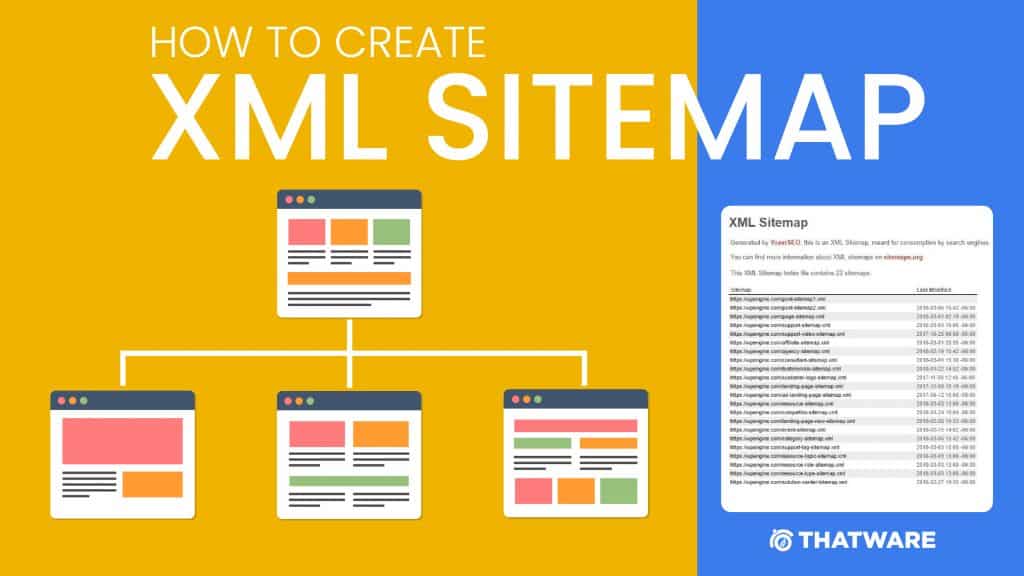
TYPES OF SITEMAP:
There are basically two types of sitemaps namely HTML and XML sitemaps but if we include and divide this Image-Sitemap, Video-Sitemap, News-Sitemap, Mobile-Sitemap into sections we could provide a better view of website layout for a search engine to crawl efficiently.
HTML-SITEMAP:
The main features of HTML-sitemaps are logical groups of the website’s content as well as a clear map of the website with a reasonable hierarchy.HTML-sitemap is intended specifically for the user, as opposed to an XML-sitemap. It is supposed to be a graphical table-of-contents for the website, which will also help search engines crawl the entire website.
HTML sitemap links the resources internally and internal links help in improving keyword rankings; these sitemaps also help linked webpages in their rankings with search engines.
XML-SITEMAP:
XML is basically a language that stores information about an object in an organized or pre-defined format. These XML files not only contain the list of the webpages but also information about the webpages like when the webpage was modified, what is the preference of the webpage as compared to other webpages, how often is the webpage modified and much more. There are many online tools available that can help you create sitemaps very easily.
An XML-Sitemap, as opposed to an HTML-sitemap, is a structured index created specifically for search engines, in order to help them find either new, sparsely linked or deeply nested pages.
IMAGE-SITEMAP
An image-sitemap is an XML-sitemap created specifically for images and their contents.
Using an image-XML-sitemap, you can add specific information, such as the location (geo_location), to the images on your website and submit them to Google. Adding a separate image-sitemap can be helpful for your image rankings in the Google Image
VIDEO-SITEMAP
A separate video-XML-sitemap allows you to enhance the video contents on your website with additional information, like defining a category to which the video belongs to. This helps videos rank better in Google Video Search.
Google also recommends adding the specific schema.org markup to your video content, this will help to develop the Video Rich Snippet Generator for schema.org Markup.
NEWS-SITEMAP:
By using a separate news-XML-sitemap, you can complement your own news content – which you have optimized specifically for Google-News – with publication-specific information, like the release date. Adding a news-sitemap can positively influence your rankings within Google News.
MOBILE-SITEMAP:
If a website delivers mobile content specifically for “feature-phones”, you should add a mobile XML-sitemap. This does not concern smartphones, as they have a full-fledged browser available.
Feature-phones are phones that do not have a full-fledged browser and use WAP/WML, etc.
Architectural Look
Here’s a glimpse of how an XML sitemap looks like:
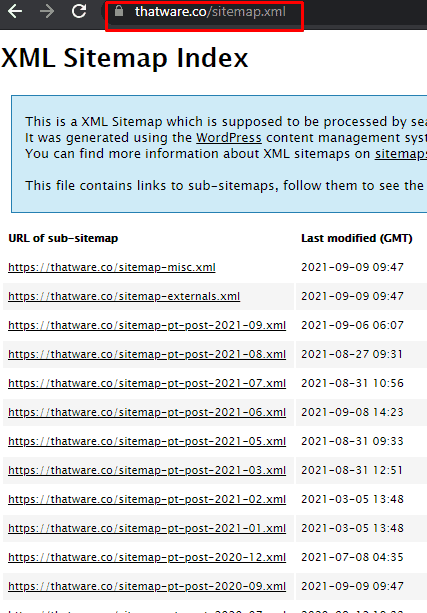
Purpose behind XML sitemap
Here’s what the information looks like in a sitemap:
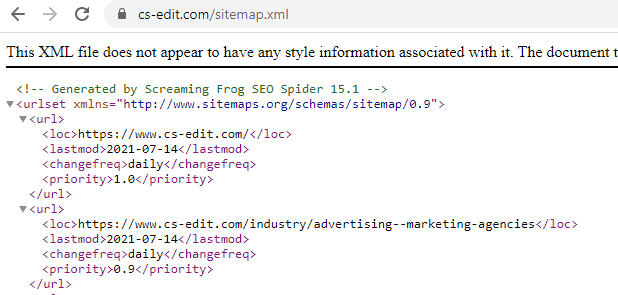
- The path of the webpage located on the website as shown above (its URL): <loc>https://www.cs-edit.com/</loc>
- When the webpage was last changed: <lastmod>20213-17-14</lastmod>
- How frequently the webpage is changed: <changefreq>daily</changefreq>
- Priority between the page to other pages on the site: <priority>1.0</priority>
This competence of an XML sitemap to assist crawlers in faster indexation is especially crucial for websites that:
- Have plenty of pages
- Every now and then add new pages.
- Frequently change content of existing pages.
- Weak internal linking and orphan pages.
- Lesser external link profile.
Side note: Sitemap consisting of noindex URLs can also boost up deindexation. And if you add this on Google Search Console it will assist you with the procedure.
XML Sitemap Best SEO Practices
First up, create your sitemap instantly. If you use WordPress CMS then you can opt for the Yoast SEO plugin, it has an in-built XML sitemap feature. Here’s how it looks:
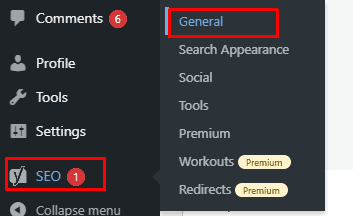
Go to the WordPress dashboard, then at the far bottom, you will have a Yoast setup, from there browse the General tab to explore the feature.

By default, it will appear as above, you need to switch it on to activate the sitemap for the website. Once you activate the sitemap, the sitemap will appear as follows. You can type /sitemap.xml after your domain URL to see the live file.
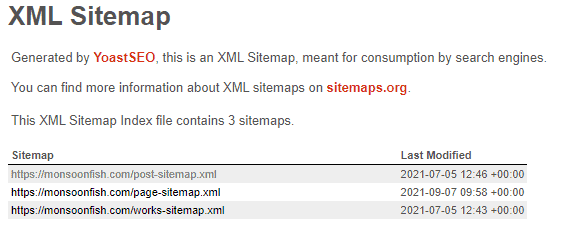
Benefits of Yoast Sitemap
The prime benefit of using the Yoast SEO plugin sitemap is that it dynamically updated each time when you add any page or post on your WordPress site.
Basically, e-commerce sites tend to get much more benefits using this plugin.
The SEO Sitemap plugins you can use as follows:
Google XML Sitemaps , All in One SEO Pack, etc.
For those who are not using WordPress, that you can use the following site to create a sitemap online:
https://www.xml-sitemaps.com/.
XML Sitemap Submission to GSC
Once you are good to go with all the technical changes, please proceed with the XML sitemap submission in Google Search Console as shown here:
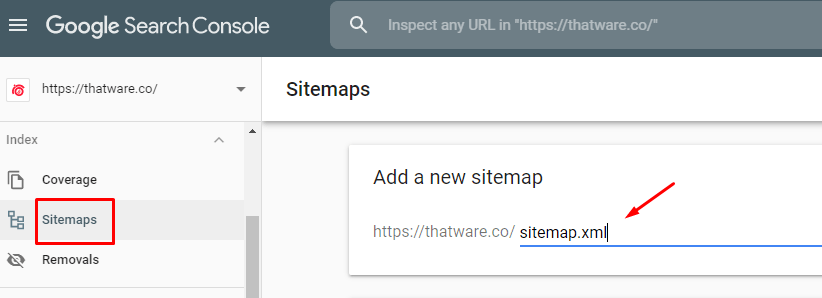
Submit Your Sitemap To Google
To submit your sitemap log in to your Google Search Console account.
Then, go to “Index” segment → “Sitemaps” in the left sidebar.

Once the submission is done in GSC, you’ll start to see information on your sitemap on this page under the “Submitted Sitemaps” section.
If you see as shown below, “Sitemap index processed successfully”, then Google successfully crawled your sitemap.

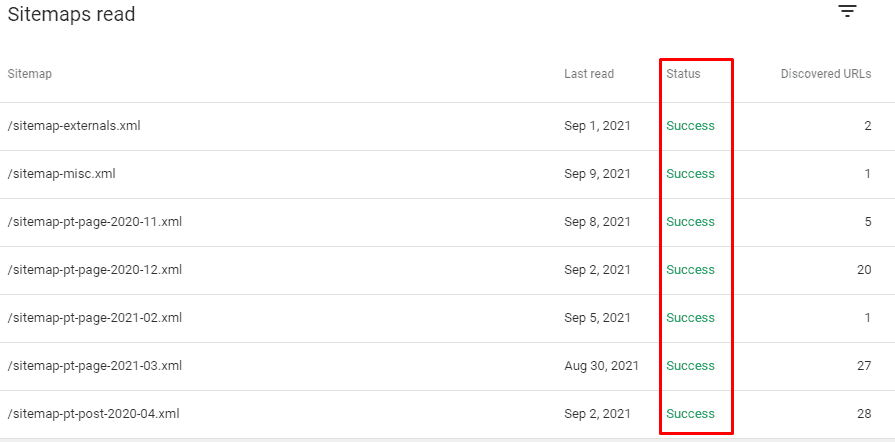
Pro Tip Here
Don’t forget to match your robots.txt file’s sitemap name with your exact sitemap URL or else you need face errors in Google Search Console.
Why Choose ThatWare for SEO Sitemap Fixation?
- Expertise in Technical SEO: At ThatWare, we specialize in technical SEO and understand the critical importance of sitemaps in optimizing website architecture for search engines. Our team consists of seasoned SEO professionals with extensive experience in sitemap fixation, ensuring that your sitemap is structured correctly to maximize crawlability and indexing by search engines like Google.
- Customized Solutions: We recognize that every website is unique, and sitemap requirements may vary based on factors such as website size, content structure, and business goals. That’s why we offer customized solutions tailored to your specific needs. Whether you’re looking to prioritize certain URLs for indexing or address issues with sitemap errors or inconsistencies, our team can devise a tailored strategy to meet your objectives effectively.
- XML Sitemap Expertise: While HTML sitemaps have their place, XML sitemaps are the preferred choice for search engine optimization due to their ability to provide detailed information about URLs to search engines. At ThatWare, we specialize in creating and optimizing XML sitemaps to ensure maximum visibility and crawlability for your website’s content. Our expertise in XML sitemap generation and optimization enables us to create sitemaps that adhere to best practices and help improve your website’s overall SEO performance.
- Comprehensive Approach: Our approach to SEO sitemap fixation goes beyond simply generating a sitemap file. We conduct a thorough analysis of your website’s architecture, content, and crawlability to identify areas for improvement. Whether it’s optimizing URL structure, implementing proper pagination, or resolving issues with URL canonicalization, we take a comprehensive approach to ensure that your sitemap aligns with your SEO objectives and contributes to better search engine rankings.
- Continuous Monitoring and Optimization: At ThatWare, we understand that SEO is an ongoing process, and sitemap fixation is no exception. That’s why we provide continuous monitoring and optimization services to ensure that your sitemap remains effective over time. Whether it’s updating sitemap configurations, adding new URLs, or addressing crawl errors, our team is dedicated to ensuring that your sitemap continues to support your SEO efforts and drive organic traffic to your website.
Additional Benefits of Using XML Sitemaps for SEO
1. Enhanced Efficiency of Crawl
XML sitemaps are essential for increasing your website’s crawl performance. XML sitemaps facilitate the faster and more accurate discovery of new and updated content by search engines like Google and Bing by offering a structured list of all the URLs on your website.
Advantages:
- Faster Discovery: The XML sitemap makes sure that search engines are notified right away when you update or add new material to a website. As a consequence, your newly created content will show up in search results more quickly.
- Allocation of Resources: The resources available to search engines for web crawling are restricted. They may prioritize which sites to crawl with the use of an XML sitemap, making sure that the most crucial and recent pages are viewed first.
- Decreased Crawl mistakes: XML sitemaps assist lessen the possibility of crawling mistakes, such as missing pages or duplicate content problems, by directing search engines through the structure of your website.
Example:
Consider managing an online store with hundreds of product pages. Search engines may overlook recently introduced items or take longer to reindex updated ones if you don’t have an XML sitemap. This might cause delays in search visibility and possibly missed sales. These items are swiftly indexed via an XML sitemap, guaranteeing their rapid appearance in search results.
2. Enhancement for Media Content:
Image and video Specialized sitemaps made to offer more details about your media material are called XML sitemaps. Your rankings in media-specific searches can be greatly increased by using these sitemaps, which aid search engines in comprehending and indexing your movies and photos more effectively.
Advantages:
- Enhanced Visibility: You may increase the likelihood that your photos and videos will show up in pertinent search results by including comprehensive information about them, such as titles, descriptions, and locations.
- Improved User Engagement: You may increase user engagement and possibly improve your overall SEO performance by using high-quality photos and videos to draw in more visitors and keep them on your website for longer.
- Rich Snippets: By making your listings more aesthetically attractive, video sitemaps can help you meet the requirements for rich snippets in search results, which can raise your click-through rate (CTR).
Example:
To make sure these media assets are correctly indexed, a travel blog with stunning photos and films of various locations might employ picture and video sitemaps. Higher ranks in Google Images and Google Video Search may result from this, bringing additional visitors to the site from people looking for visual material in particular.
3. Support for Large Websites
Making sure all of the pages on large, intricate websites are indexed and crawled by search engines may be difficult. In these situations, XML sitemaps are very helpful since they make it easier for search engines to efficiently browse through the vast amount of material on the website.
Advantages:
- Entire Coverage: XML sitemaps make sure that every page is included in the crawling and indexing process, even the deep and infrequently updated ones.
- Organized Structure: They aid in the preservation of an orderly structure, which facilitates search engines’ comprehension of the connections between the various pages and parts of your website.
- Scalability: XML sitemaps are simply updated to reflect new material as your site expands, providing ongoing and effective indexing without the need for manual intervention.
Example:
As an illustration, picture a news website with hundreds of stories, tags, and categories. Search engines may find it difficult to locate and index all the articles—especially the older ones—without an XML sitemap. Every article, no matter how deep it is in the site hierarchy, is guaranteed to be scanned and indexed by an XML sitemap, improving content exposure overall.
4. Enhanced Indexing of Orphan Pages
Orphan pages are web pages that are difficult for search engines to find through routine crawling because they lack internal links leading to them. By offering a direct connection to these orphan sites and making sure they are indexed, an XML sitemap can assist in resolving this problem.
Advantages:
- Enhanced Indexation: By including orphan pages into your XML sitemap, you make sure that search engines don’t miss them, which can enhance your site’s overall indexation.
- Whole Content Discovery: Your whole content, including those without internal links, may be found and indexed by search engines, giving you a more extensive online presence.
- Enhanced SEO Performance: By adding more indexed pages and maybe generating more traffic, indexing orphan pages can improve the overall SEO performance of your website.
Example:
For instance, a photographer’s web portfolio may have a number of project sites that aren’t connected from the home page or other internal pages. If not indexed, these orphan pages will not show up in search results. By adding these sites to an XML sitemap, you can make sure that search engines find and index them, which will make them available to prospective clients looking for particular kinds of photographic assignments.
Technical Aspects and Best Practices for XML Sitemaps
It’s important to focus on technical details and follow best practices if you want to get the most out of your XML sitemaps and improve your SEO performance. We explore three essential methods that may greatly improve the functionality and effectiveness of your XML sitemaps below:
- Segmenting Large Sitemaps
For particularly big websites, keeping a single, lengthy sitemap can be time-consuming and inefficient. Segmenting your sitemap into smaller, more manageable sections can help with organization and indexing.
Benefits:
- Improved scan Efficiency: Smaller sitemaps are easier for search engines to scan and process, ensuring that all of your material is indexed properly.
- Enhanced Management: Segmenting your sitemaps based on logical groups, such as product categories, blog sections, or media formats, makes it easier to update and manage them.
- Error Reduction: Splitting a huge sitemap allows you to more quickly detect and fix particular issues within each segment, lowering the risk of widespread mistakes.
Implementation:
- Produce Multiple Sitemaps: Separate your website’s content into logical categories and produce a sitemap for each. For example, an e-commerce website may have separate sitemaps for items, categories, blog articles, and media assets.
- Use a sitemap index file: A sitemap index file is an XML file that contains references to many sitemaps, allowing search engines to more easily identify and explore each sitemap. This file serves as a master list, pointing to all segmented sitemaps.
Example:
An online shop with a large inventory can construct distinct sitemaps for fiction, non-fiction, children’s books, and e-books. The sitemap index file will then refer to these distinct sitemaps, ensuring that each category gets scanned and indexed sequentially.
Choose ThatWare for SEO sitemap fixation and leverage our expertise, customized solutions, XML sitemap expertise, comprehensive approach, and continuous monitoring and optimization to enhance your website’s crawlability, indexing, and overall search engine visibility. With ThatWare, you can trust that your sitemap is in capable hands, enabling you to achieve your SEO goals with confidence.
Optimize Your Website with XML Sitemaps – ThatWare
In the fast-paced world of digital marketing, ensuring your website is easily discoverable by search engines is crucial. One of the most effective ways to achieve this is through an XML sitemap, a structured file that helps search engines crawl and index your website efficiently. At ThatWare, we specialize in advanced SEO solutions and implementing an optimized XML sitemap is a key component of our strategy.
Why XML Sitemaps Matter?
An XML sitemap acts as a roadmap for search engines, guiding them through your website’s most important pages. This is especially beneficial for large websites, e-commerce platforms, and newly launched sites that need faster indexing. By using a well-structured sitemap, you ensure that search engines like Google and Bing can find all your pages, even those with fewer internal links.
How ThatWare Enhances Your XML Sitemap?
At ThatWare, we go beyond basic sitemap generation. Our AI-driven SEO approach ensures:
✔ Proper URL Structuring – Eliminating duplicate URLs and prioritizing important pages.
✔ Automatic Updates – Keeping your sitemap fresh with newly published content.
✔ Error-Free Submission – Ensuring search engines can access and crawl the file seamlessly.
✔ Mobile & Video Sitemaps – Enhancing visibility for different content formats.
With ThatWare’s cutting-edge SEO solutions, your website can achieve higher rankings, better indexing, and improved user experience. Contact us today to optimize your XML sitemap for maximum search engine visibility!
Why ThatWare’s XML Sitemaps Are Smarter, Faster, and Always in Sync
At ThatWare, an XML sitemap isn’t just another checkbox on an SEO audit—it’s a live, breathing framework that communicates directly with search engines. While most agencies treat it like a static list of URLs, we build dynamic, AI-aided sitemaps that evolve in real-time with your website’s structure, authority, and search goals.
Here’s the difference: ThatWare’s XML sitemaps are machine-generated for efficiency but human-refined for strategy. We analyze crawl frequency, orphan pages, indexation gaps, and content depth using intelligent systems. If a high-value blog post is buried too deep, we prioritize it. If outdated pages are hogging crawl budget, we smartly remove them.
We go a step further by embedding multimedia tags, hreflang attributes, and canonical signals directly into the sitemap where applicable. This helps Google and other crawlers understand international targeting, content hierarchy, and page relationships instantly. For ecommerce brands or large-scale platforms with frequent inventory changes, ThatWare automates change frequency, last modified dates, and priority rules—keeping sitemaps clean and current.
But what really sets us apart is our cross-validation system. We don’t just generate sitemaps—we cross-check them with server log data to ensure alignment with how bots actually crawl your site. If your sitemap says one thing but Googlebot behavior suggests another, we fix it—fast.From complex enterprise sites with deep content silos to fast-scaling businesses with dynamic URLs, ThatWare delivers XML sitemaps that do more than guide bots—they drive rankings. Because real SEO power lies not in telling search engines where to go, but in knowing how to lead them there. That’s the ThatWare advantage: precision-engineered visibility that works smarter, not harder.
How ThatWare Can Optimize Your Sitemap for SEO Growth
As a cutting-edge SEO company, ThatWare goes beyond basic sitemap submissions to deliver precision-based, AI-powered sitemap strategies tailored for real SEO impact. Our team uses proprietary tools and advanced audit systems to ensure your XML sitemap isn’t just technically correct — it’s strategically aligned with your business goals and search engine expectations.
We begin with a deep crawl and indexation audit powered by machine learning to identify which pages are vital for discovery and which ones dilute crawl equity. Based on your website’s size, structure, and industry, ThatWare customizes sitemap strategies that prioritize high-converting, high-ranking potential URLs while removing noise such as redirected, orphaned, or non-canonical pages.
For enterprise-level sites or complex ecommerce platforms, our systems segment XML sitemaps by content type — products, blogs, categories, landing pages — to ensure better tracking and crawl efficiency. We also leverage AI-driven behavior analysis to dynamically update your sitemap with the most relevant and frequently accessed pages.
As a professional SEO agency, ThatWare has helped brands across sectors—from SaaS to retail—witness measurable gains in organic traffic by optimizing their sitemaps. Our case studies reveal significant increases in indexed pages, crawl frequency, and keyword visibility within weeks of implementation.
Ready to transform your sitemap into a high-performance SEO asset? Get started with ThatWare’s Free XML Sitemap Audit today. Let us show you how intelligent sitemap management can accelerate your digital growth.
The Importance of Sitemaps for Website Success
A sitemap is an essential part of every website, acting as a roadmap that helps search engines like Google understand the structure of your site. It allows search engines to crawl and index the content of your website more efficiently, improving visibility and accessibility. Whether you’re building a new website or enhancing an existing one, understanding and implementing a well-structured sitemap is key to achieving better search engine rankings and ensuring your content reaches the right audience.
What is a Sitemap and Why Is It Important?
A sitemap is a file that lists all the pages of your website, acting as a guide for search engines to crawl and index your site. There are two main types of sitemaps: XML sitemaps and HTML sitemaps.
- XML Sitemaps are specifically designed for search engines. They allow search engines to easily find all pages on your website and index them, making it more likely that your content will appear in search results.
- HTML Sitemaps are more user-friendly. They allow visitors to navigate your site easily by providing a clear and organized view of your content.
By having an updated and correctly structured sitemap, search engines can crawl your website faster, making it easier for them to index your content and deliver it to search users. It also helps prevent issues like orphaned pages that search engines might miss.
How Sitemaps Improve SEO
Having a comprehensive and well-structured sitemap can significantly improve your SEO efforts. Sitemaps act as a vital tool to ensure that your website’s pages are crawled and indexed correctly.
- Improved Indexing: A sitemap helps search engines understand the structure of your site. This way, they can index all relevant pages accurately, which leads to better ranking opportunities.
- Faster Crawling: For websites with numerous pages or complex structures, sitemaps enable search engines to crawl them faster. This ensures that new content is indexed quickly, keeping your website up-to-date in search results.
- Better User Experience: By having an HTML sitemap, you provide a user-friendly interface that helps visitors navigate your site easily. This can enhance the overall user experience and reduce bounce rates, indirectly boosting your SEO.
- Priority & Frequency Settings: With XML sitemaps, you can specify the priority and update frequency of pages. This tells search engines which pages are most important and how often to revisit them for updates.
ThatWare’s Expertise in Sitemap Optimization
At ThatWare, we understand the importance of sitemaps for both search engine visibility and user experience. Our expert team is skilled in crafting and optimizing sitemaps tailored to your website’s structure. We ensure that your sitemap is well-organized, up-to-date, and fully optimized for both XML and HTML formats.
Our team also ensures that your sitemap is integrated with Google Search Console and other important tools for maximum SEO impact. We provide full support, ensuring that your website is visible to search engines and easily accessible to your users.
Key Services We Offer:
- XML Sitemap Creation & Optimization: We create and optimize XML sitemaps, ensuring your website is easily crawled and indexed by search engines.
- HTML Sitemap Design: We design user-friendly HTML sitemaps that improve site navigation and enhance the overall user experience.
- Sitemap Submission: We help submit your sitemaps to Google Search Console and other search engines to improve visibility.
- Continuous Monitoring & Updates: As your website grows and changes, we keep your sitemaps updated and monitor their performance to ensure that everything is optimized for maximum SEO benefits.
Get Started with ThatWare
A well-structured sitemap is crucial for the success of any website. With ThatWare’s expert services, we help you take control of your website’s structure, ensuring that search engines and visitors can navigate it seamlessly. Let us help you optimize your sitemap for the best possible performance.
To get started, visit ThatWare today and learn more about how we can assist you in enhancing your website’s SEO through effective sitemap management.

